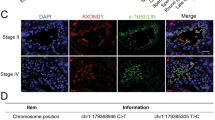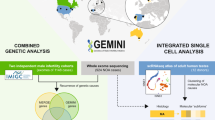Abstract
We isolated the complete deleted-in-azoospermia-like-1 (DAZL1) gene of the old world monkey Macaca fascicularis (tentatively designated as MafaDAZL1) and compared its sequence structure to that of the other DAZL1 genes isolated so far. In addition to the homologous RNA recognition motif (RRM domain), we only identified a high conservation of the Mafa-DAZL1 coding region to the mammalian DAZL1 genes (i.e. mouse: Dazl1; and human: DAZL1) and to that of Xenopus (xdazl). Only in the primates, Macaca fascicularis and human, sequences and lengths of the 5′ and 3′ untranslated DAZL1 gene structures (UTRs) displayed a similar conservation as their coding regions (i.e. 91–94%). Both belong to the primate class of old world monkeys evolutionarily separated 36–55 million years ago (1). The strong conservation of the complete DAZL1 gene structure in both primate species suggests a similar control and maturation pathway of DAZL1 transcripts in the germ line of old world monkeys and also indicates a homologous function of the DAZL1 RNA-binding protein in this primate class.
Similar content being viewed by others
References
Martin R.D. Primate origins: plugging the gaps. Nature 1993, 363: 223–233.
Karashima T., Sugimoto A., Yamamoto M. Caenorhabditis elegans homologue of the human azoospermia factor DAZ is required for oogenesis but not for sermatogenesis. Development 2000, 127: 1069–1079.
Eberhart C.G., Maines J.Z., Wasserman S.A. Meiotic cell cycle requirement for a fly homologue of human Deleted in Azoospermia. Nature 1996, 381: 783–785.
Maegawa S., Yasuda K., Inoue K. Maternal mRNA localization of zebrafish DAZ-like gene. Mech. Dev. 1999, 81: 223–226.
Houston D.W., Zhang J., Maines J.Z., Wassermann S.A., King M.L. A Xenopus DAZ-like gene encodes an RNA component of germ plasm and is a functional homologue of Drosophila boule. Development 1998, 125: 171–180.
Cooke H.J., Lee M., Kerr S., Ruggiu M. A murine homologue of the human DAZ gene is autosomal and expressed only in male and female gonads. Hum. Mol. Genet. 1996, 5: 513–516.
Reijo R., Seligman J., Dinulos M.B., Jaffe T., Brown L.G., Disteche C.M., Page D.C. Mouse autosomal homolog of DAZ, a candidate male sterility gene in humans, is expressed in male germ cells before and after puberty. Genomics 1996, 35: 346–352.
Burd C.G, Dreyfuss G. Conserved structures and diversity of functions of RNA binding proteins. Science 1994, 265: 615–621.
Saxena R., Brown L.G., Hawkins R., Alagappan R.K., Skaletsky H., Reeve M.P., Reijo R., Rozen S., Dinulos M.B., Disteche C.M., Page D.C. The DAZ gene cluster on the human Y chromosome arose from an autosomal gene that was transposed repeatedly amplified and pruned. Nat. Genet. 1996, 14: 292–299.
Shan Z, Hirschmann P., Seebacher T., Edelmann A., Jauch A., Morell J., Urbitsch P., Vogt P.H. A SPGY copy homologous to the mouse gene Dazla and the Drosophila gene boule is autosomal and expressed only in the human male gonad. Hum. Mol. Genet. 1996, 5: 2005–2011.
Yen P.H, Chai N.N., Salido E.C. The human autosomal gene DAZLA: testis specifity and a candidate for male infertility. Hum. Mol. Genet. 1996, 5: 2013–2017.
Seboun E., Barbaux S., Bourgeron T., Nishi S., Agulnik A., Egashira M., Nikkawa C., Bishop C.E., Fellous M., McElreavey K., Kashara M. Gene sequence, localization, and evolutionary conservation of DAZLA, a candidate male sterility gene. Genomics 1997, 41: 227–235.
Reijo R., Lee T.Y., Salo P., Alagappan R., Brown L.G., Rosenberg M., Rozen S., Jaffe T., Straus D., Hovatta O., de la Chapelle A., Silber S., Page D.C. Diverse spermatogenic defects in humans caused by Y chromosome deletions encompassing a novel RNA-binding protein gene. Nat. Genet. 1995, 10: 383–393.
Maiwald R., Seebacher T., Edelmann A., Hirschmann P., Köhler M.R., Kirsch S., Vogt P.H. A human Y-chromosomal gene mapping to distal Yq11 is expressed in spermatogenesis. In: Affara N., Bishop C., Brown W., Cooke H., Davey P., Ellis N., Graves J.M., Jones M., Mitchel M., Rappold G. (Eds.), Report of the Second International Workshop on Human Y Chromosome mapping 1995. Cytogenet. Cell Genet. 1996, 73: 33–76.
Vogt P.H., Edelmann A., Kirsch S., Henegariu O., Hirschmann P., Kiesewetter F., Kohn F.M., Schill W.B., Farah S., Ramos C., Hartmann H., Hatscluh W., Mesched D., Behre H.M., Castel A., Nieschlag E., Weidun W., Gröve H.-J., Jung A., Engel W., Haidl G. Human Y chromosome azoospermia factors (AZF) mapped to different subregions in Yq11. Hum. Mol. Genet. 1996, 5: 933–943.
Vogt P.H. Human chromosome deletions in Yq11, AZF candidate genes and male infertiliy: history and update. Mol. Hum. Reprod. 1998, 4: 739–744.
Vogt P.H., Affara N., Davey P., Hammer M., Jobling M.A., Lau Y.-F.C., Mitchell M., Schempp W., Tyler-Smith C., Williams G., Yen P., Rappold G.A. Report of the Third International Workshop on Y Chromosome Mapping 1997. Cytogenet. Cell Genet. 1997, 79: 1–20.
Gromoll J., Weinbauer G.F., Skaletsky H., Schlatt S., Rocchietti-March M., Page D. C., Nieschlag E. The old world monkey DAZ (Deleted in Azoospermia) gene yields insights into the evolution of the DAZ gene cluster on the human Y chromosome. Hum. Mol. Genet. 1999, 8: 2017–2024.
Ausubel F.M, Brent R., Kingston R.E., Moore D.D., Seidman J.G., Smith J.A., Struhl K. Current Protocols in Molecular Biology. John Wiley & Sons, New York, 1989.
Makalowski W., Boguski M.S. Evolutionary parameters of the transcribed mammalian genome: An analysis of 2,820 orthologous rodent and human sequences. Proc. Natl. Acad. Sci U.S.A. 1998, 95: 9407–9412.
Sheets M.D, Ogg S.C., Wickens M.P. Point mutations in AAUAAA and the poly(A) addition site: effects on the accuracy and efficiency of cleavage and polyadenylation in vitro. Nucleic Acid Res. 1990, 18: 5799–5805.
Ruggiu M, Speed R., Taggart M., McKay S.J., Kilanowski F., Saunders P., Dorin J., Cooke H.J. The mouse Dazla gene encodes a cytoplasmic protein essential for gametogenesis. Nature 1997, 389: 73–77
Short R.V. The testis: the witness of the mating system, the site of mutation and the engine of desire. Acta Paediatr. 1997, 422 (Suppl.): 3–7.
Burgoyne P.S. Fruit(less) flies provide a clue. Nature 1996, 381: 740–741.
Ruggiu M, Saunders P.T, Cooke H.J. Dynamic subcellular distribution of the DAZL protein is confined to primate male germ cells. J. Androl. 2000, 21: 470–477.
Jackson R.J. Cytoplasmic regulation of mRNA function: the importance of the 3’ untranslated region. Cell 1993, 74: 9–14.
Carani C., Gromoll J., Brinkworth M., Simoni M., Weinbauer G.F., Nieschlag E. cynDAZLA: a cynomolgus monkey homologue of the human autosomal DAZ gene. Mol. Hum. Reprod. 1997, 3: 479–483
Author information
Authors and Affiliations
Corresponding author
Rights and permissions
About this article
Cite this article
Grossmann, B., Weinbauer, G., Hirschmann, P. et al. Conservation of the deleted-in-azoospermia-like-1 (DAZL1) gene structure in old world monkeys points to a homologous function of DAZL1 in this primate class. J Endocrinol Invest 23, 616–622 (2000). https://doi.org/10.1007/BF03343785
Published:
Issue Date:
DOI: https://doi.org/10.1007/BF03343785




